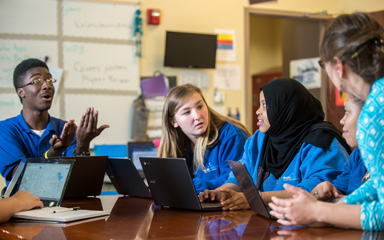Full Transparency
Our editorial transparency tool uses blockchain technology to permanently log all changes made to official releases after publication. However, this post is not an official release and therefore not tracked. Visit our learn more for more information.
In Math, they made QR codes to help kids find homework aids. In Art, they created drawings recalling the kaleidoscopic patterns of cancer cells, and placed them as decor around the school.
For freshman Alyssa Kish, the best part was the Science and Environment class in which students played the parts of doctor, lawyer, patient, patient’s relatives, and others involved in the ethical dilemmas involved with cell-harvesting.
“I was the doctor,” said Alyssa, who hopes to become a doctor to special-needs children, “and I supported the option of communication — you know, that we should tell the family what we were doing. Unlike the doctor in the book.”
She sounded well-versed in questions of medical ethics. But before she’d read the book? “I had no clue.”
For sophomore Brandon Hout, the most striking moments came when his science class used Chromebooks to search online for images of HeLa cells and made drawings of them.
Costner, an aspiring architect, said he gained an appreciation for chemistry when his chem class examined the uncanny ability of the HeLa’s cells to replicate.
“I have the ability to to assess my students in real time, using Google Forms. I have data, I have statistics and world clouds — there’s no more guessing involved as to what your students do or don’t know.”
Shai Fears, a junior, enjoyed his English class most, “the fact that we were able to write essays and compare and contrast lives, ours and hers.” Hoping for a career as a physical therapist and a preacher, he said the book made him ask “what would we do in that situation, knowing you had that many kids and you had that problem with your health and not many people knowing.”
For Principal Hank Stopinski, the most profound activity might have been the field trip to Roswell Park Cancer Center, a major hospital and research center, in downtown Buffalo. There, students saw oncologists and researchers at work. And there the book came alive. Students saw some of the actual HeLa cells.
“It was very, very powerful,” Stopinski said.
Health Sciences Charter School is in downtown Buffalo, too, but its 450 students arrive there from a different world. More than 80 percent live below the poverty line. The

high school was founded four years ago in a long-abandoned orphanage to introduce motivated but disadvantaged kids to health-science professions, plying the academic rigor to prepare them for college and careers. The first graduating class donned mortarboards this spring.
“The kids are awesome,” said teacher Nora Buchman. “You can’t talk to them and not have a happy attitude.”
The students, in turn, think the world of the school. “It’s a really tight-knit community where everyone helps each other,” said Brandon Hout, a sophomore.
Rebecca Skloot’s 2010 work, “The Immortal Life of Henrietta Lacks,” was a perfect book for this school, Buchman said, for it deals not only with health and science but “themes of race, ethics and morality.”
Teachers spent months preparing for the year of HeLa-based lessons. “Our team was absolutely brilliant,” said Buchman, recently named the school’s technology coach. “They came up with so many approaches for using Henrietta Lacks.”
Much of the preparation relied upon teachers’ ability to confer among themselves and with teachers from other schools in online forums. Verizon’s help, in money and equipment, made that possible, Stopinski said.
In one of those online forums, Buchman learned in detail how to “flip” her classroom so that she no longer lectures; her students use computers in class to work through the course material at their own pace, reading texts, watching videos, writing out exercises in Google Docs, taking interactive quizzes. Buchman works the room, conferring with students one at a time.
“They can raise their hand, and I can give them an extra level of help,” Buchman said.

Only in her first year of teaching, the 27-year-old Buchman feels lucky to be launching her career at a time of rapid technological change. “I don’t think I could have lasted otherwise,” she said jokingly. “I have the ability to to assess my students in real time, using Google Forms. I have data, I have statistics and world clouds — there’s no more guessing involved as to what your students do or don’t know.”
Being a VILS school for two years has brought Health Sciences Charter an influx of tablets, Chromebooks and connectivity, That has tapped great veins of creativity in learning, according to Buchman, who was a translator of Russian, Ukrainian and Polish before becoming a teacher.
“Having those in the classroom really contributed to bringing that multimedia experience to the kids — videos, clips, the author reading it out loud, ” Buchman said. “I can say that VILS really empowered us to connect with other teachers going through the same experience” at other schools.
“I think it was fantastic,” Stopinski, the principal, said of the one-book project. “We’ve decided on a book for next year.”
It’s “A Long Way Gone: Memoirs of a Boy Soldier,” by Ishmael Beah, a story of modern war in Africa.
How to make that story relevant to science and math classes, as well as the more obvious social studies and English?
That’s the next challenge for the ambitious educators at Health Science Charter School.
